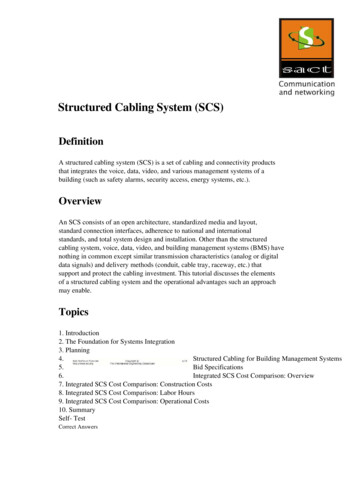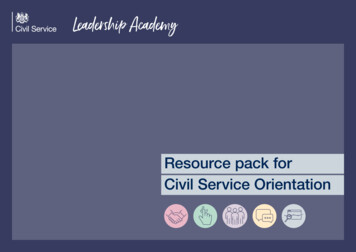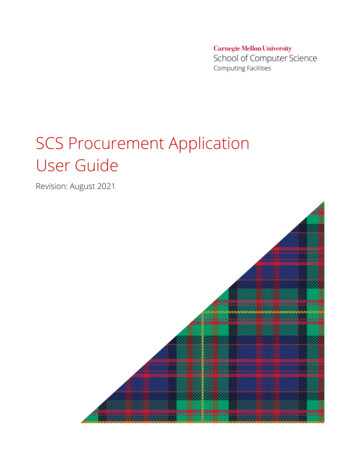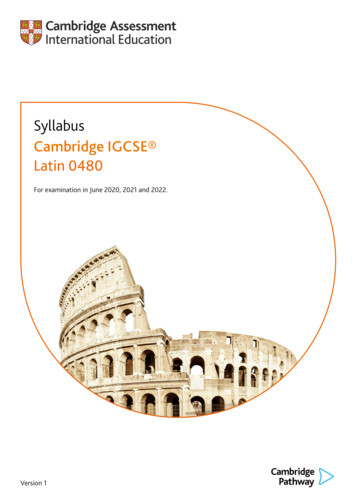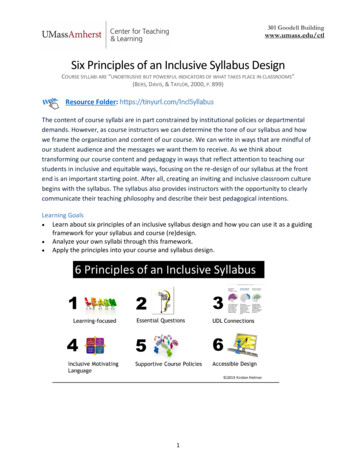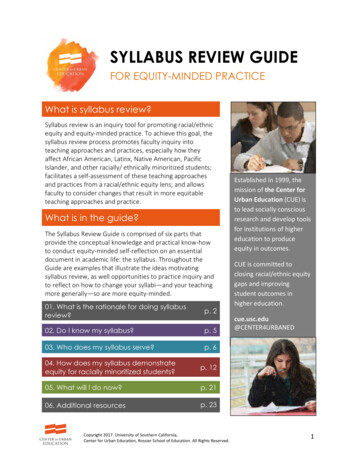
Transcription
SYLLABUSMTech (NM)1st SEMESTERSession 2021‐2022Mission of SCS&IT, DAVVTo produce world‐class professionals who have excellent analytical skills,communication skills, team building spirit and ability to work in cross culturalenvironment.To produce international quality IT professionals, who can independently design,develop and implement computer applications.Professionals who dedicate themselves to mankind, who are environmentconscious, follow social norms and ethics.School of Computer Science & IT,Devi Ahilya Vishwa Vidyalaya, Indorewww.scs.dauniv.ac.in
Course Name MTech (NM) 1st SemesterSubject Code: CS‐6624Subject Name: Network ManagementAim of the SubjectTo familiarize the student with the design, analysis, operation and management ofdata communications networks.Objectives1. Provide understanding of the fundamental concepts of networkmanagement.2. Build a theoretical foundation of Network Management Protocols amongstudents.3. Provide the student with a working knowledge of the types ofcommunications network management systems, their strengths andweaknesses in solving various network management problems.4. Equip the students with an in‐depth knowledge of how to install, maintain,and manage a Local Area Network, which helps the students to understandthe actual working of computer network.Unit 1Introduction: Computer Network, Goals and Applications, Data Communications andNetwork Management Overview : Communications protocols and Standards. CaseHistories of Networking and Management, Network Management: Goals,Organization, and Functions, Network and System Management, NetworkManagement System Platform, Current Status and future of Network Management.1 of 3MTech (NM) 1st SEM1. Understand the structure and organization of computer networks;including the division into netwo rk layers, role of each layer, andrelationships between the layers.2. In depth understanding of transport layer concepts and protocol design;including connection‐oriented a nd connection‐less models, techniques toprovide reliable data delivery, and algorithms for congestion control and flowcontrol.3. In depth understanding of various network management standards andtheir perceptive.4. Understand the SMTP protocol and its working in detail.5. Understand the basic concepts of broadband network Telecommunicationnetwork and their management.5. Knowledge of Network Management Tools and Network ManagementApplications: Configuration management, Fault management, performancemanagement, security management and accounting management.Session 2021‐2022Learning Outcomes
Fundamentals of computer network technology: Network Topology, LANs, Networknode components Hubs, Bridges, Routers, Gateways, Switches, WAN, ISDNTransmission Technology. Network Management Standards, Network ManagementModel, Organization Model, Information Model, Communication Model, ASN.1,Encoding Structure.Unit 2SNMPv1 Network Management: Managed network: Case Histories and Examples,The History of SNMP Management. The SNMP Model, The Organization Model,System Overview. The Information Model, The SNMP Communication Model,Functional Model.SNMPv2 Management: Major Changes in SNMPv2, SNMPv2 System Architecture,SNMPv2 Structure of Management Information. The SNMPv2 ManagementInformation Base, SNMPv2 Protocol, Compatibility with SNMPv1.Unit 3Unit 4Broadband Network Management: Broadband Access Networks and Technologies,HFC Technology, HFC Management, DSL Technology, ADSL Technology, ADSLManagement.Telecommunication Management Network: Introduction, Operations Systems, TMNconceptual Model, TMN Architecture, TMN Management Service Architecture, Anintegrated view of TMN.Unit 5Network Management Tools and Systems: Network Management Tools, NetworkStatistics Measurement Systems, History of Enterprise Management. NetworkManagement systems, Commercial Network management Systems, SystemManagement, Enterprise Management Solutions.Network Management Applications: Configuration management, Fault management,performance management. Event Correlation Techniques, security Management,Accounting management, Report Management, Policy Based Management ServiceLevel Management.Text Book(s)2 of 3Session 2021‐2022andMTech (NM) 1st SEMSNMP Management‐RMON: Introduction, RMON SMI and MIB, RMON1.Broadband Network Management‐ATM Networks: Broadband NetworksServices, ATM Technology, ATM Network Management.
Mani Subrahmanian, Network Management: Principles and Practice, PearsonEducation, 2nd Edition 2010.Reference Material(s)MTech (NM) 1st SEMSession 2021‐2022 Morris, Network management, Pearson Education. Mark Burges, Principles of Network System Administration, Wiley DreamtechPublication. Paul, Distributed Network Management, John Wiley Publication. Andrew S. Tanenbaum, Computer Networks, Addison‐Wes3 of 3
Course Name MTech (NM) 1st SemesterSubject Code: CS‐6220Subject Name: Internet Programming Using JavaAim of the SubjectTo make students learn fundamental concept of coding and perform thempractically and to develop problem‐solving skillsObjectives1.To make students learn the basics of coding.2.To develop concepts in a lo gical and creative way.Unit 1Review of java concepts: Features of Java, Object‐oriented programming overview,Introduction of Java Technologies, How to write simple Java pro grams, Data Types,Variables, Memory concepts, control statements, looping, Method Call StackandActivation Record, Argument Promotion and Casting, Scope of declaration andMethod Overloading, String Handling: The String constructors, String operators,Character Exaction, String comparison, String Buffer. Arrays: Declaring and Creating1 of 2MTech (NM) 1st SEMDescription of knowledge to be acquired:A student completing course unit 1 should :1. Have an understanding of basics of coding with syntax.2. To perform concepts practically including topics of core java.A student completing course unit 2 should :1. Have understanding of concepts logically.2. Develop programming solving skills.3.Have improvement of mathematical logics.4.understand of concepts practically of inheritance ,exceptional handling,multithreading ,applets and Jdbc.A student completing course unit 3 should :1.Have understanding of fundamentals of HTTP and servlets.2.Have understanding methods and to perform them practically.A student completing course unit 4 should :1.Have understanding of basics of Jsp2.Have understanding of Jsp lifecycle and connection of Jsp with differentdatabase like oracle, ms‐sql server and performing operations.A student completing course unit 5 should :1.Have understanding of basics of EJB and its types.2.Have knowledge of creating and working with session bean.Session 2021‐2022Learning Outcomes
Arrays, Enhanced for Statement, Passing Arrays to Method, MultidimensionalArrays, Variable‐Length Argument lists, Using Command‐line ArgumentsUnit 2Inheritance: Extending classes & related things. Packages and Interfaces: Defininga Package, Understanding CLASSPATH, Access Protection, Importing packages,creating own packages Exception Handling: Introduction, overview of doing it andkeywords used, when to use it, Multithreading: What are threads, The java threadmodel, Thread priorities, Thread life cycle, Thread Synchroniza tion, Applets: Appletbasics, Applet Architecture, Applet life cycle methods, Databas e connectivity: JDBC,The design of JDBC, Typical uses of JDBCUnit 3Introduction to HTTP, web Server and application Servers, Installation ofApplication servers, Config files, Web.xml. Java Servlet, Servlet DevelopmentProcess, Deployment Descriptors, Generic Servlet, Lifecycle of Servlet. ServletPackages, Classes, Interfaces, and Methods, Handling Forms with Servlet, Variousmethods of Session Handling, various elements of deployment descriptors.Unit 5MVC Architecture Introduction to Remote Method Invocation, Introduction toEnterprise Java Bean, Types of EJB, Creating and working with Session BeanText Book(s)1. Java 2: The Complete Reference by Herbert Schildt, Tata McGraw‐ Hill,8thEdition, 2011.2. K. Mukhar, “Beginning Java EE 5: From Novice to Professional”, Wrox Press.Reference Material(s)1. The Java Programming Language, Ken Arnold , James Gosling , David Holmes, 3rdEdition, Person Education, 2000.2. Head First Java, Kathy Sierra, Bert Bates, O’Reilly Publication, 2nd Edition, 20053. M. Hall, L. Brown, “Core Servlets and Java Serve2 of 2MTech (NM) 1st SEMJSP Basics: JSP lifecycle, Directives, scripting elements, standard actions, implicitobjects. Connection of JSP and Se rvlet with different database viz. Oracle, MS‐SQLServer, MySQL. java.sql Package. Querying a database, adding records, deletingrecords, modifying records, types of Statement. Separating Business Logic andPresentation Logic, Building and using JavaBean. Session handli ng in JSP, Types oferrors and exceptions handling.Session 2021‐2022Unit 4
Course Name MTech (NM) 1st SemesterSubject Code: CS‐5615Subject Name: Information SecurityAim of the SubjectThe main aim of this course is to provide students with a background, foundation,and insight into the many dimensions of information security.Objectives1. Understand information security’s importance in our increasinglycomputer‐driven world.2. Master the key concepts of information security and how they “work.”3. Develop a “security mindset:” learn how to critically analyze situations ofcomputer and network usage from a security perspective, identifying thesalient issues, viewpoints, and trade‐offs.Unit 1Computer Security Concepts, Introduction to Information Security, Confidentiality,Integrity, and Availability, Assets and Threats etc.Unit 2Basic Cryptographic Concepts, Symmetric Encryption Algorithms, Purpose ofCryptography, Data Encryption Standard (DES), Triple DES, Advanced EncryptionStandard (AES) etc.Unit 3Public‐Key Encryption, Introduction to Public‐Key Cryptography, Public‐KeyEncryption Algorithms, RSA Public‐Key Algorithm, Diffie‐Hellman Algorithm etc.1 of 2MTech (NM) 1st SEM1. Explain the challenges and scope of information security;2. Explain such basic security concepts as confidentiality, integrity, andavailability, which are used frequently in the field of informa tion security;3. Explain the importance of cryptographic algorithms used in i nformationsecurity in the context of the overall information technology (IT) industry;4. Identify and explain symmetric algorithms for encryption‐bas ed securityof information;5. Identify and explain public‐key based asymmetric algorithms forencryption‐based security of information;6. Describe the access control mechanism used for user authentication andauthorization;Session 2021‐2022Learning Outcomes
Unit 4Access Control Mechanisms, Authentication, Access Control and Authorization,SecurityProtocols and Solutions, Internet Protocol Security, Secure Sockets Layer, PrettyGoodPrivacy.Unit 5Firewalls, Intrusion Detection, and Intrusion Prevention, Security Protocols andSolutions, Firewall, Host‐Based IDS vs. Network‐Based IDS, Network Attacks andDefense.Text Book(s)Stallings William, Cryptography and Network Security: Principles and Practice, 6thEdition, Pearson/Prentice‐ Hall.Reference Material(s)Session 2021‐2022Mathew Bishop; Computer Security; Art and Science; Addison‐Wisley Oct. 2007Mathew Bishop; Introduction to computer Security; Addison‐Wisley Oct 2004Kaufman, Perlman and Speciner; “Network security”; Pearson Education 1995.Atul Kahate; “CrypMTech (NM) 1st SEM1.2.3.4.2 of 2
Course Name MTech (NM) 1st SemesterSubject Code: CS‐6622Subject Name: Advanced Computer NetworkAim of the SubjectThis course aims to provide advanced background on relevant com puter networkingtopics to have a comprehensive and deep knowledge in computer networks.Laboratory Work: consists of creating simulated networks and pa ssing packetsthrough them using different routing techniques.Objectives1. To study the problematic of service integration in TCP/IP networksfocusing on protocol design, implementation and performance issues.2. To debate the current trends and leading research in the computernetworking area.Unit 1Review of Basic Network Architectures: OSI reference model, TCP/IP referencemodel, ATM reference model; Applications (WWW, Audio/Video Streaming, Videoconference, Networked Games, Client/Server); Traffic Characterization (CBR, VBR);Switching Paradigms; Multiplexing; Error Control; Flow Control, SONET, OpticalNetworks.Unit 2Local Area Network Technologies: Wired LANS: Ethernet Protocol, IEEE MACSublayer protocols ‐ 802.3, 802.4, 802.5 and their management, Fast Ethernet,Gigabit Ethernet, Wireless LANs, IEEE 802.11 Project, Bluetooth, Connecting LANs.Unit 3Internetworks: Host‐to‐Host Delivery, Addressing ‐ classful and classlessaddressing, subnetting and supernetting. Internetworking: Inter domain Routing,Border Gateway Protocol version 4, IPv6, Multicast Routing Protocols, Multi‐Protocol Label Switching, Virtual Private Networks, High speed transport protocols,Quality of Service Mechanisms, Improving QoS in Internet.1 of 2MTech (NM) 1st SEM1. To identify and discuss the concepts underlying IPv6 protocol, and theirmain characteristics and functionality.2. To understand the principles a nd functionality of mobile IP, explaining itsconcretization in IPv6; to understand the needs of optimization of themobility mechanisms and description of some extensions that aim to reducehandover latency and requirements from terminals.3.To recognize the need for service integration and discuss how it can beaccomplished.Session 2021‐2022Learning Outcomes
Unit 4Distributed Systems: Naming, DNS, DDNS, Paradigms for Communication in Internet,Caching, Issues of Scaling in Internet and Distributed Systems, Caching Techniquesfor Web, Protocols to Support Str eaming Media, Multimedia Transport Protocols,Content Delivery Networks, Overlay and P2P Networks.Unit 5Applications and Other Networking Technologies: RTP, RTSP, SIP, VoIP, SecuritySystems, SSH, PGP, TLS, IPSEC, DDoS Attack, Mitigation in Internet, Security inMPLS; Introduction to Cellular, Satellite and Ad hoc Networks.Text Book(s)1. Behrouz A. Forouzan, Data Communications and Networking, Fourth Ed., TataMcGraw Hill.2. 2. Larry L. Peterson and Bruce S. Davie, Computer Networks: A Systems Approach,Fourth Ed., Morgan Kaufmann .MTech (NM) 1st SEM1. Jean Walrand and Pravin Varaiya, High performance Communication Networking,2nd Ed., Morgan Kaufmann, 1999.2. Markus Hoffmann and Leland R. Beaumont, Content Networking: Architecture,Protocols, and Practice, Morgan Kaufmann, 2005.Session 2021‐2022Reference Material(s)2 of 2
Stallings William, Cryptography and Network Security: Principles and Practice, 6th Edition, Pearson/Prentice‐ Hall. Reference Material(s) 1. Mathew Bishop; Computer Security; Art and Science; Addison‐Wisley Oct. 2007 2. Mathew Bishop; Introduction to computer Security; Addison‐Wisley Oct 2004 3. Kaufman, Perlman and Speciner; "Network .

